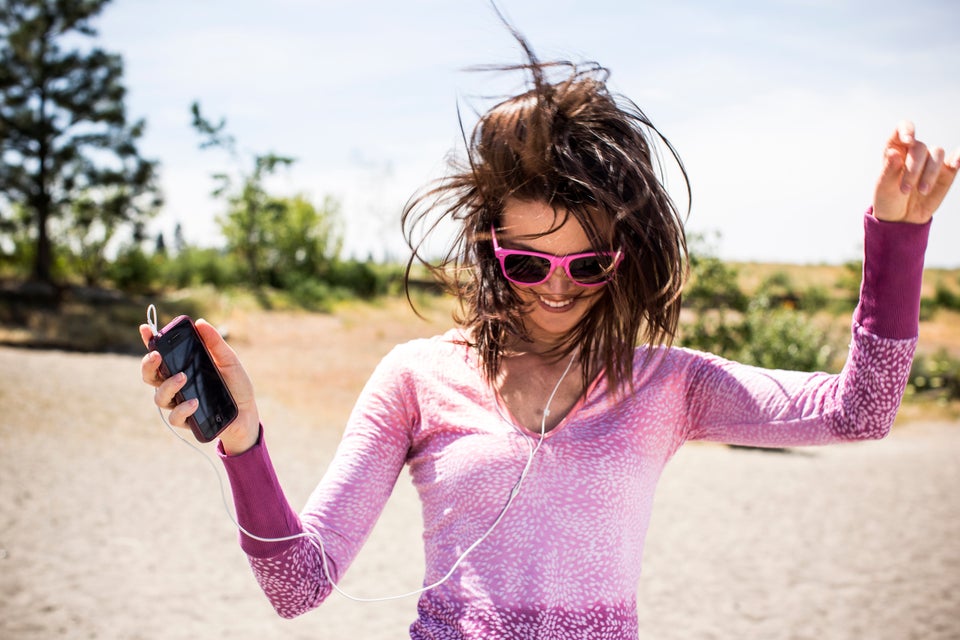Pole dancing. It sounds like a counterintuitive activity for women with chronic pain. But there’s a wave of women who have adopted this art, sport, and form of dance – yes, it can be all three – and found relief.
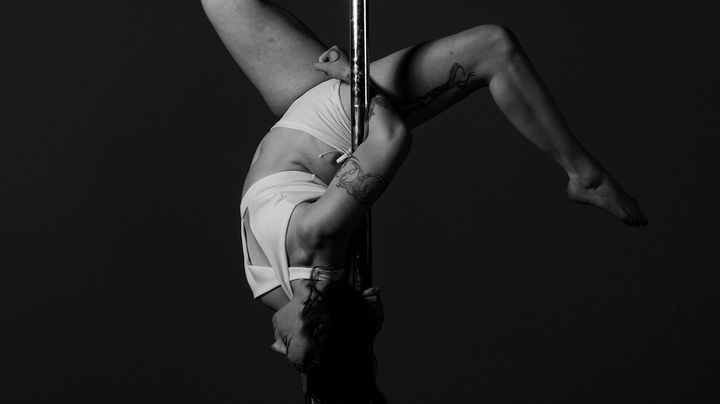
Photo credit: Jody Ryker by Matt Haber
The popularity of pole dancing has grown tremendously over the past decade, with studios all over the world offering classes to people of all ages, sizes, and abilities. Even science has grown interested in the benefits of pole dancing. Last year, the University of Western Australia recruited pole dancers to take part in a study to determine the physical and mental benefits.
While pole dancing has a darker association as an exploitative occupation, there are women with chronic pain who have found (and built) a new love for their body, incredible strength to manage the pain, and a sense of community in this empowering exercise. This beautiful marriage of benefits helps them battle their pain.
Learning how to love your body again
Exercise in general is recommended for conditions that cause chronic pain, such as fibromyalgia and rheumatoid arthritis. Exercise has positive benefits for chronic pain, and pole dancing, while unconventional, can be ideal because it engages all of the body’s muscles.
“One of greatest rewards is learning how to love your body again.”
Pole dancing develops the body’s core along with both upper and lower body strength. And while there are risks — the most common being bruising, skin burn, and shoulder problems from hanging from one arm — these don’t outweigh the reward.
Many people who experience chronic pain feel like their bodies have betrayed them. “You feel like you’re not really in love with your body because it’s hard to love something that is always in pain,” says Christina Kish, the founder of Poletential, located in Redwood City, CA. “But pole allows you to be in the moment where you’re not having pain and your body is doing really amazing things.”
Kish used to work in the high tech industry and was a co-founder of Netflix. Her journey through finding pole dancing and opening her own pole dancing business 11 years ago has provided her with insight about the activity.
The people who are most reluctant to come into her studio and try pole dancing often get the most benefit from it. “Anything that can consume you and take all of your focus, allowing you to have a break from the pain, is such a relief,” says Kish.
They find their body can do things they never would have anticipated. The other thing about it is that people come to this when they’re in a moment of transition, so it’s not a workout for sport. They’re really able to work though the mind-body connection using this particular apparatus.—Christina Kish, founder of Poletential
Kish ended up leaving her position as VP of Marketing at Netflix due to burnout and chronic pain. The combination made it impossible for her to keep up with the daily responsibilities of her job. She has an undiagnosed issue where both of her eyes “have a squeezing fatigue-type pain all of the time.” It’s been there for a long time — since 1995. The pain she has is still ever-present and the intensity depends on how she manages it.
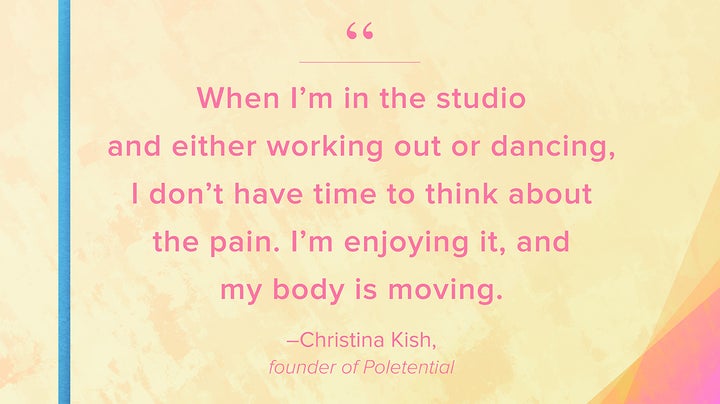
According to another pole aficionado, Carlie Leduc, the full-body incorporation and strength buildup from pole dancing has greatly helped her with managing chronic pain. “I’ve never done a sport that has utilized my core, my upper body, my legs, and everything else,” she says. She practices headstands, which have ended the neck spasms she used to experience by strengthening the surrounding muscles. “Becoming more active has made me more vested in keeping my body as pain-free as possible … and staying on top of it on a daily basis.”

Photo credit: Christina Kish
Even the Arthritis Foundation lists pole dancing as a recommended exercise for RA. “Regular movement, and definitely stretching, helps my hip pain,” says Jody Ryker, who has arthritis as a result of the autoimmune disease Sjögren’s syndrome. She’s a dancer and aerialist in Santa Cruz, CA, and the founder of Pole Diversity.
In a different, yet parallel, struggle, Ryker says she must constantly dispel the perception that all pole dancers are strippers. In January 2016, Daily Dot reported on a hashtag controversy around pole dancers who wanted to disassociate themselves from the stigma of being a stripper, using the hashtag campaign #NotAStripper on Instagram. Those who did strip for a living took offense, responding back with #YesAStripper, as the art has sex worker origins that can’t be ignored.
Ryker isn’t a stripper, but she states emphatically, “People should treat strippers and sensual dancers with more respect.” Battling this stigma is why Ryker is inspired to put together a circus type of dancing. Ryker characterizes her dancing as lyrical in style and says the community is blown away by her routines.
No matter their background, those who participate in pole dancing — whether as an art, sport, hobby, career, or workout — should be able to do so without judgment looming over them.
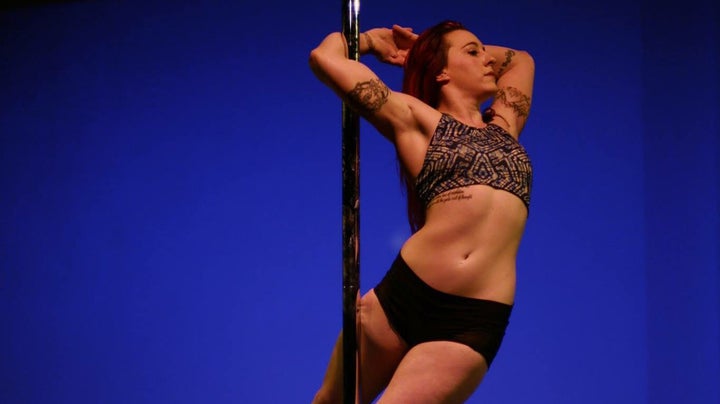
Photo credit: Adam Freidin
Support from an open community
This embracing atmosphere is what appeals to most practitioners. The broad-based and open community accepts people of all backgrounds, orientations, and sizes.
“I love the community,” says Leduc, who is also a pole dancing teacher in San Francisco. “The majority are women, queer men, and people from the transgender community.”
Ryker shares similar sentiments. “I’ve finally found a community. Everyone comes from a different background, but it’s one of the most accepting communities I’ve ever been in. When I used to go to dance classes, I never felt I fit in because I have a lot of tattoos and bulky muscles. But with pole, you can be yourself and be welcomed.”
Leduc recalls her learning process. To her, she’s always had a “squishy belly” she didn’t like and was really self-conscious about her body. But, through learning and practicing pole dancing, she learned to love and become comfortable with her body.
But, pain relief is the ultimate goal.
“I’m a pretty Type A person,” admits Kish, “but when I walk into the studio, the whole world goes away. It’s the only time and place I’ve been fully present, and that includes not thinking about how much pain I’m in.”
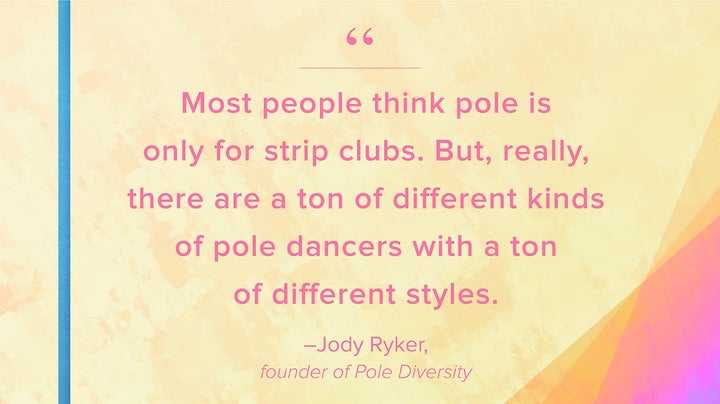
And you can hear it in the stories of these amazing women. They all report a dramatic change in their lives since discovering pole dancing. This art, sport, or form of dance is also an identity they’ve built and developed. It’s a core foundation of the things that make life beautiful: pain relief, body acceptance, a supportive community, and a world to call their own.
Stephanie Schroeder is a New York City-based freelance writer and author. A mental health advocate/activist, Schroeder published her memoir, Beautiful Wreck: Sex, Lies & Suicide, in 2012. She is currently co-editing the anthology HEADCASE: LGBTQ Writers and Artists on Mental Health and Wellness, which will be published by Oxford University Press in 2018/2019. You can find her on Twitter @StephS910.
The original article was published on Healthilne.com.
